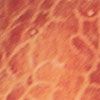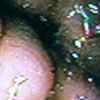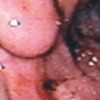Complications of Alcohol Abuse
A 65-year-old woman with a history of alcohol abuse, hospitalized because of acute pancreatitis, had had petechial hemorrhages on her legs for the past 3 months.
Hyperglobulinemic Purpura in a Woman With Cirrhosis
K. AKRITIDIS, MD, N. GIZAS, MD, and M. MASTORA, MD
Ioannina, Greece

A 65-year-old woman with a history of alcohol abuse, hospitalized because of acute pancreatitis, had had petechial hemorrhages on her legs for the past 3 months. These hemorrhages-pinhead-size and slightly larger-were diagnosed as hyperglobulinemic purpura, a condition that occurs predominantly in women. It affects dependent parts of the body, particularly the lower legs. Mucous membranes are not usually involved.
With this finding, it is necessary to rule out systemic lupus erythematosus, Sjgren syndrome, multiple myeloma, cryoglobulinemia, chronic lymphocytic leukemia, rheumatoid arthritis, and cirrhosis. In this case, serum protein electrophoresis showed polyclonal hyperglobulinemia, and liver biopsy results were compatible with alcoholic cirrhosis.
"Snakeskin" Gastric Mucosa
KLAUS E. MONKEMULLER, MD
Magdeburg, Germany
C. MEL WILCOX, MD
University of Alabama at Birmingham

Cirrhosis and ascites developed in a 52-year-old man with a history of chronic hepatitis C and alcohol abuse. He was hospitalized because of bleeding esophageal varices, which were successfully treated with elastic band ligation. Seen here is an endoscopic view of the patient's stomach with the classic macroscopic "snakeskin" appearance of portal hypertensive gastropathy-a fine reticular pattern that separates areas of erythematous mucosa. Histological examination disclosed extensive edema and submucosal vessel dilation.
The mucosa is extremely friable in those with portal hypertensive gastropathy, and it is postulated that spontaneous rupture of the ectatic vessels results in bleeding. Management of such bleeding aims to decrease the portal pressure-ideally, to less than 12 mm Hg. Therapies include portacaval shunt surgery, transjugular intrahepatic portosystemic shunt, nitrates, and b-blockers (if not contraindicated by left-sided heart failure or chronic obstructive pulmonary disease). The most frequently used drug is propranolol, given orally. The initial dosage is increased gradually until the patient's baseline heart rate is lowered by 25% (or to about 60 to 70 beats per minute). Extreme care must be taken to prevent hypotension.
Electrocoagulation, injection laser therapy, and surgery are ineffective in controlling bleeding from portal hypertensive gastropathy. Sucralfate, proton pump inhibitors, and H2 blockers are similarly ineffective.
Alcohol Abuse and Rectal Varices: 2 CasesCase 1:
BENJAMIN J. MARANO, Jr, MD
Hartsdale, NY

Loose, irregular bowel movements were the complaint of a 56-year-old man. He underwent colonoscopic examination. The dilated vascular structures shown are rectal varices: portosystemic collateral veins that develop with portal hypertension. Vascular channels develop to decompress the higher-pressure portal system by shunting blood flow to the lower-pressure systemic venous system. The collateral flow involves the superior hemorrhoidal vein of the portal system and the middle and inferior hemorrhoidal veins of the systemic circulation.
Gastroesophageal varices are a more widely recognized path of collateral flow that develops with portal hypertension. Massive rectal bleeding has been reported from rectal varices, although it appears less frequently than bleeding from gastroesophageal varices.
Rectal varices must be distinguished from hemorrhoids, which represent prolapsed vascular ectatic vessels or cushions that communicate with the hemorrhoidal plexus. There has been no documentation of direct connection between hemorrhoids and either the systemic or portal veins.
In the United States, alcohol is the most common cause of liver cirrhosis and portal hypertension. Although this patient denied alcohol abuse, he mentioned that he enjoyed wine with dinner. On further questioning, the patient admitted to having consumed 1 to 1.5 L of wine each evening for many years. This had resulted in liver disease and portal hypertension, manifested as rectal varices.
Case 2:
ARMAND G. CACCIARELLI, MD, JAMES G. ROBILOTTI, MD,
and NICHOLAS M. GUALTIERI, MD
New York

Flexible sigmoidoscopy disclosed the large rectal varices seen in these 2 photos. The patient, a 50-year-old man with a history of alcohol abuse, alcoholic liver disease, and hepatitis C, had previously undergone sclerotherapy for esophageal varices. He now experienced bright red rectal bleeding that continued for several hours and finally stopped spontaneously. The varices were not bleeding at the time the examination was made, and no therapy was undertaken.

Rectal varices are seen in about half of patients with cirrhosis. They tend to develop well within the rectum-several centimeters above the pectinate line, lying proximal to the site of internal hemorrhoids. Treatment includes sclerotherapy, banding, placement of underrunning sutures, and portosystemic shunts. Massive rectal bleeding (although relatively infrequent) can occur after sclerotherapy for esophageal varices, as was the case here.